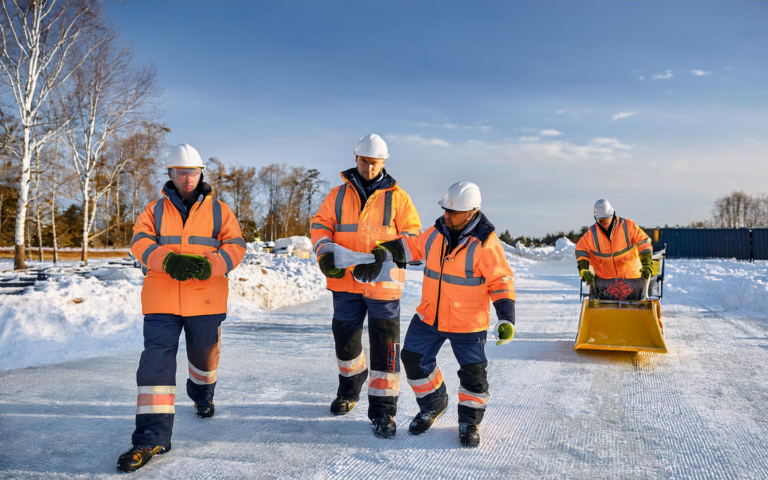
Safety in the Use of Personal Protective Equipment During Winter

Winter weather introduces specific risks for outdoor workers, including frostbite, hypothermia, and cold stress. According to the National Institute for Occupational Safety and Health (NIOSH), prolonged exposure to extreme cold without proper personal protective equipment (PPE) significantly increases the likelihood of these conditions (NIOSH, 2019). Despite advancements in workplace safety, the Bureau of Labor Statistics (BLS) reports a consistent annual increase in weather-related workplace injuries, highlighting the necessity for targeted winter safety protocols (BLS, 2022).
Personal protective equipment plays a vital role in mitigating these risks. However, the lack of appropriate PPE during winter leads to increased downtime, higher operational costs, and reduced employee morale. For industries like transportation, construction, environmental services, and general logistics, ensuring PPE adequacy in cold weather is critical to maintaining safety, compliance, and productivity.
Industry-Specific Importance of PPE in Winter
Transportation Industry
Drivers and ground crews face icy roads and subzero temperatures, which exacerbate hazards such as slips, falls, and frostbite. OSHA emphasizes that providing insulated gloves, high-visibility jackets, and anti-slip boots can reduce such risks, enabling safer operations (Occupational Safety and Health Administration [OSHA], 2019). Fleet managers must also ensure emergency kits with thermal blankets and hand warmers are readily available.
Construction Industry
Cold stress is a significant hazard for construction workers who spend prolonged hours outdoors. Adequate PPE, including windproof outerwear, insulated gloves, and waterproof boots, minimizes exposure to extreme conditions. Heated break areas and staggered schedules further enhance safety, aligning with OSHA’s cold-weather safety guidelines (OSHA, 2019).
General Industry
Warehouse workers and outdoor logistic teams face hypothermia risks when exposed to freezing temperatures during loading and unloading. Employers should ensure that all workers have layered PPE and access to warming stations. Routine monitoring and employee training on proper PPE usage are vital for compliance and injury prevention (Centers for Disease Control and Prevention [CDC], 2020).
Environmental Services
Workers handling hazardous materials in winter face dual risks from extreme weather and exposure to toxic substances. Chemical-resistant gloves, insulated hazmat suits, and temperature-regulated boots are essential for protection. Emergency response plans should include decontamination processes suitable for freezing temperatures (Environmental Protection Agency [EPA], 2022).
The Four Pillars of Winter PPE Safety
- Prevention: Provide insulated PPE tailored to job requirements and educate employees on recognizing cold stress symptoms (OSHA, 2019).
- Preparedness: Develop detailed protocols for extreme weather conditions, including contingency plans and equipment checks (Ready.gov, 2023).
- Response: Establish real-time monitoring systems for weather updates and deploy mobile warming stations during prolonged exposure (National Weather Service [NWS], 2022).
- Recovery: Conduct post-incident reviews to ensure PPE efficacy and adapt protocols based on lessons learned (NIOSH, 2019).
Best Practices for PPE Safety in Winter
- Layer PPE for optimal thermal insulation.
- Conduct regular PPE inspections for wear and tear.
- Provide training on proper PPE donning and doffing techniques.
- Maintain extra PPE on-site to handle unexpected weather changes.
- Equip workers with anti-slip footwear and portable heating gear.
Proactive measures enhance employee safety and contribute to operational resilience.
Key Safety LLC’s Role in Winter PPE Safety
At Key Safety LLC, we specialize in developing tailored safety solutions, including:
- Comprehensive winter PPE protocols aligned with OSHA standards.
- Training programs to educate employees on winter hazards and proper PPE use.
- Audits to ensure compliance with DOT, EPA, and FRA guidelines.
Our expertise empowers businesses to create safer environments for their teams, ensuring compliance and productivity even in harsh winter conditions.
Subscribe to our newsletter for ongoing updates on workplace safety and visit our blog for in-depth insights into PPE strategies tailored for winter challenges.
References
Centers for Disease Control and Prevention. (2020). Cold stress. CDC. https://www.cdc.gov/niosh/topics/coldstress/default.html
Environmental Protection Agency. (2024). Winter weather and indoor air quality. EPA. https://www.epa.gov/emergencies-iaq/winter-weather-and-indoor-air-quality
National Institute for Occupational Safety and Health. (2019). Workplace safety and health topics: Cold stress. CDC. https://www.cdc.gov/niosh/topics/coldstress/
National Weather Service. (2022). Winter weather safety and preparedness. NOAA. https://www.weather.gov/safety/winter
Occupational Safety and Health Administration. (2019). Winter weather: Cold stress. OSHA. https://www.osha.gov/winter-weather/cold-stress
Ready.gov. (2023). Winter weather safety. Ready.gov. https://www.ready.gov/winter-weather
Bureau of Labor Statistics. (2022). Workplace deaths from weather and atmospheric conditions. U.S. Department of Labor. https://www.bls.gov/opub/ted/2022/workplace-deaths-from-weather-and-atmospheric-conditions.htm

